A chilling temperature is any temperature that is cold enough to cause plant injury but not cold enough to freeze the plant. These temperatures usually range from just above 32°F to about 59°F. Chilling injury to tropical foliage plants is also dependent on the duration of exposure to a chilling temperature.
Chilling injury can occur to tropical foliage plants if greenhouses become too cold. Chilling injury can also occur if plants are exposed to chilling temperatures outside of the greenhouse during packing and shipping. During winter months, if plants are transported in unheated trucks, left exposed on shipping docks, or if retail display merchants do not sufficiently maintain warm environments, foliage may be damaged (Chen et al. 2005). Commercial interiorscapes (e.g., design, installation, and maintenance of live plants in airports, hotels, malls, and restaurants) and retail consumers may also report chilling injury to tropical foliage plants if indoor temperatures fall low enough and for long enough for damage to occur (Chen et al. 2005).
Dieffenbachia, commonly known as dumb cane, belongs to the plant family Araceae and ranks among the top five most popular foliage plant genera produced and sold in the United States, based on the annual wholesale value (USDA 2014).
Since the aesthetic appearance of Dieffenbachia is directly related to foliage color and quality, any damage on leaves caused by chilling, regardless of severity, can greatly reduce its ornamental value in the market place.
Chilling Injury Symptoms
Chilling injury in Dieffenbachia is first indicated by visual foliar blemishes. Leaf injury symptoms include yellowing (chlorosis) (Figure 1), water-soaked patches (Figure 2), and wilted leaves (Figure 3). Young leaves are injured first and show the most severe damage.
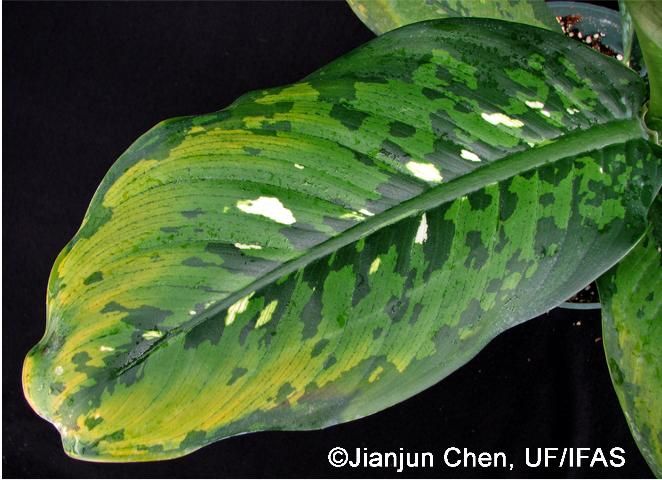
Credit: Jianjun Chen, UF/IFAS
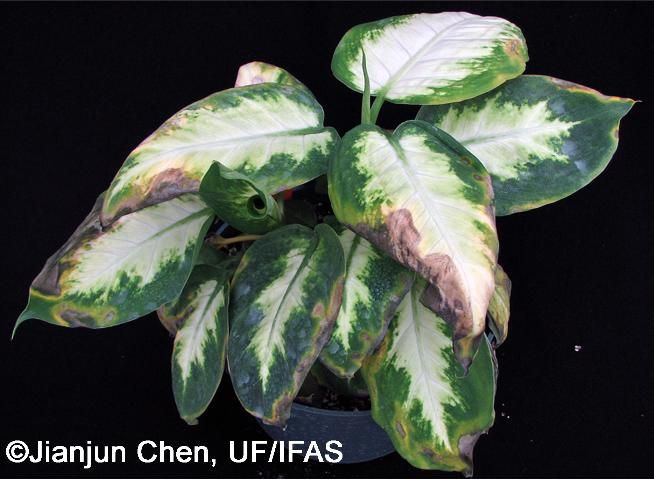
Credit: Jianjun Chen, UF/IFAS
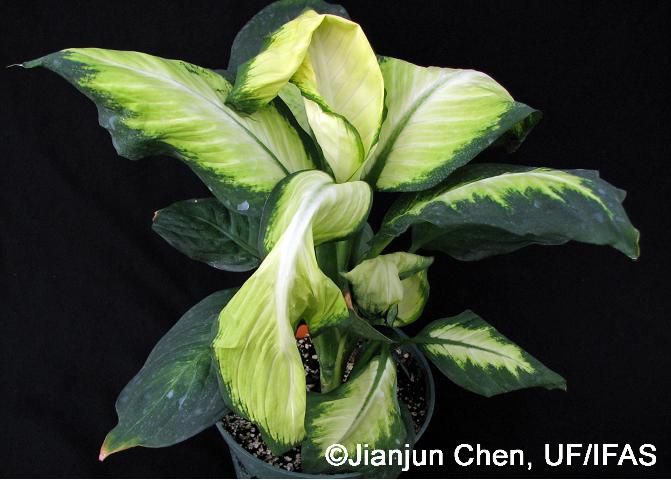
Credit: Jianjun Chen, UF/IFAS
Stem injury may also occur when Dieffenbachia is subject to chilling temperatures. Damage may be seen at the base of the stem and appear as a reddish-brown color (Figure 4). As damage progresses, the entire stem may be affected, becoming water-soaked and collapsing (necrosis) (Figure 5).
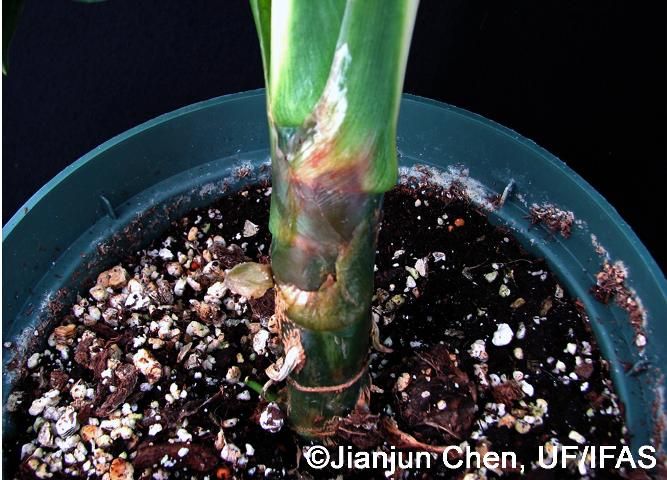
Credit: Jianjun Chen, UF/IFAS
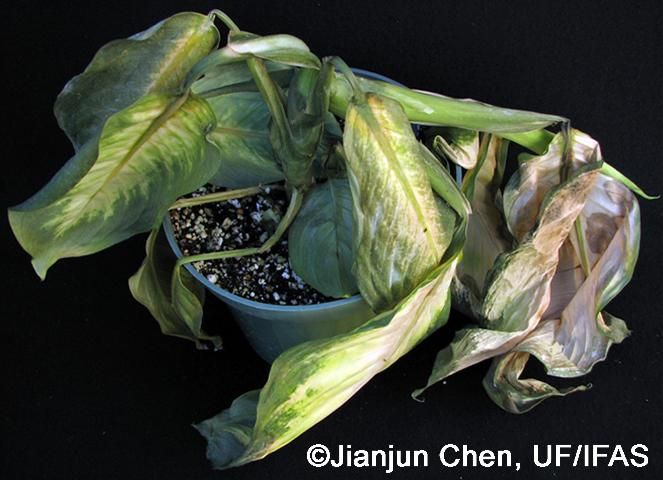
Credit: Jianjun Chen, UF/IFAS
Dieffenbachia Cultivar Responses to Chilling Temperatures
There are about 30 recognized Dieffenbachia species native to South and Central America. Because of its tropical lowland origin, Dieffenbachia is considered one of the most sensitive foliage plant genera for chilling injury. Commercially available Dieffenbachia cultivars are largely derived from D. amoena Hort. ex Gentil and D. maculata (Lodd.) G. Don via interspecific hybridization and from somaclonal variation produced by tissue culture (Henny and Chen 2004). About 100 cultivars have been introduced, but commercial production has been limited to about 20 cultivars.
A study at the UF/IFAS Mid-Florida Research and Education Center-Apopka evaluated chilling responses of eight popular Dieffenbachia cultivars: Camille, Camouflage, Carina, Octopus, Panther, Star Bright, Sterling, and Tropic Honey (Li et al. 2008).
Visible injury and growth index data generated in that study (Table 1) indicate that Dieffenbachia cultivars that are chilled at 35°F for 24 hours show great variation in the degree of chilling injury. No cultivars exhibited leaf injury after chilling at 45°F or 55°F except 'Tropic Honey,' which had 26% of leaves injured after being chilled at 45°F for 6 hours. Of the cultivars tested, 'Panther' was the most chilling tolerant cultivar because it had no leaf injury 5 days to 12 days after chilling. 'Tropic Honey' was the most sensitive cultivar as all plants died after being chilled at 35°F for 6 hours.
Relative chilling tolerance of the eight cultivars are ranked as follows: Panther (most tolerant) > Star Bright> Camouflage> Camille> Octopus> Carina> Sterling> Tropic Honey (least tolerant).
Dieffenbachia 'Panther'
No injury was observed in 'Panther' irrespective of the tested chilling temperatures and duration. Twelve days after chilling at 35°F for 24 hours, no injured leaves were observed. No stem injury occurred in 'Panther' after chilling at 35°F for 24 hours. During the subsequent three-month growth period, plant growth indices were not significantly different from respective controls after chilling at 35°F, 45°F, or 55°F.
Dieffenbachia 'Star Bright'
There was no increase in injured leaves in 'Star Bright' from 5 days to 12 days after chilling at 35°F for 24 hours. No stem injury occurred in 'Star Bright' after chilling at 35°F for 24 hours. Growth indices of 'Star Bright' chilled at 35°F for 24 hours were significantly reduced compared to those of the controls or those chilled at 45°F or 55°F during the subsequent three-month growth period.
Dieffenbachia 'Camouflage'
The percentage of injured leaves in 'Camouflage' significantly increased from 5 days to 12 days after chilling at 35°F for 24 hours. No stem injury occurred in 'Camouflage' after chilling at 35°F for 24 hours. Reduction of growth occurred after chilling at 35°F for 24 hours and at 35°F for 12 hours. Plant growth indices were not significantly different from respective untreated controls after chilling at 45°F or 55°F.
Dieffenbachia 'Camille'
Leaf injury occurred after chilling at 35°F for 12 hours. Stem injury occurred after chilling at 35°F for 24 hours. During the subsequent three-month growth period, growth after chilling at 35°F for 24 hours was significantly reduced compared to plants chilled at 45°F or 55°F or to untreated controls.
Dieffenbachia 'Octopus'
Leaf injury occurred in 'Octopus' chilled at 35°F for 6 hours. Leaf injury occurred following chilling at 35°F for 12 hours, and the percentages of injured leaves significantly increased from 5 days to 12 days after chilling. No stem injury occurred in 'Octopus' after chilling at 35°F for 24 hours. During the subsequent three-month growth period, growth indices of 'Octopus' chilled at 35°F for 24 hours were significantly reduced compared to those of the controls or chilled at 45°F or 55°F. Plant growth indices were not significantly different from respective controls after chilling at 45°F or 55°F.
Dieffenbachia 'Carina'
Leaf injury occurred in 'Carina' chilled at 35°F for 12 hours. The percentages of injured leaves in 'Carina' significantly increased from 5 days to 12 days after chilling. Stem injury occurred in 'Carina' after chilling at 35°F for 24 hours. The injury was characterized by a reddish-brown color at the stem base. Initially, this chilling exposure caused wilting of some leaves, and eventually entire shoots of 'Carina' collapsed. During the subsequent three-month growth period, growth indices of 'Carina' chilled at 35°F for 12 hours and at 35°F for 24 hours were significantly reduced compared to those chilled at 45°F or 55°F or to the controls. Plant growth indices were not significantly different from respective controls after chilling at 45°F or 55°F. It is interesting to note that there was no visible injury to 'Carina' chilled at 35°F for 6 hours, but growth indices decreased significantly.
Dieffenbachia 'Sterling'
No immediately visible leaf injury occurring in 'Sterling' chilled at 35°F for 6 hours, but the percentages of injured leaves significantly increased from 5 days to 12 days after chilling, and subsequent growth indices decreased significantly. Visible leaf injury occurred, and there was a subsequent reduction in growth after chilling exposure at 35°F for 12 hours. Stem injury occurred in 'Sterling' after chilling at 35°F for 24 hours, eventually resulting in the collapse of the entire shoots.
Dieffenbachia 'Tropic Honey'
All 'Tropic Honey' chilled at 35°F died regardless of the tested chilling durations. Young leaves of Dieffenbachia 'Tropic Honey' wilted within 3 hours. Water-soaked patches appeared in 2 days. All young leaves died (became necrotic), and older leaves wilted 3 days later. Entire shoots collapsed 10 days after chilling (Figure 5). Stem injury occurred in 'Tropic Honey' after chilling at 35°F for 24 hours. The entire stem became water-soaked and then collapsed. 'Topic Honey' had 30% less growth index after chilling at 45°F and 55°F than the control. Browning of the root system due to chilling exposure has been observed in Dieffenbachia 'Tropic Honey'.
Conclusion
Information presented here may assist growers to better manage greenhouse temperatures for the production of Dieffenbachia cultivars during winter months. Growers may also incorporate chilling-tolerant cultivars into commercial foliage production schedules to conserve energy normally used for greenhouse heating. Additionally, chilling-tolerant tropical plant cultivars can be used in breeding programs in order to develop new cultivars with better chilling tolerance (Henny and Chen 2004).
References
Chen, J., D.B. McConnell, D.J. Norman, and R.J. Henny. 2005. "The foliage plant industry." Hort. Rev (Amer. Soc. Hort. Sci.). 32:47–112.
Henny, R.J. and J. Chen. 2004. "Cultivar development of ornamental foliage plants." Plant Breed. Rev. 23:245–290.
Li, Q., J. Chen, R. H. Stamps, and L. R. Parsons. (2008) "Variation in chilling sensitivity among eight Dieffenbachia cultivars." HortScience 43:1742–1745.
USDA (United States Department of Agriculture). 2014. Floriculture Crops 2013 Summary. Washington, DC: USDA